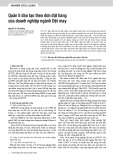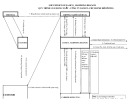
* Corresponding author. Tel.: +919948536763
E-mail address: drpurusotham.or@gmail.com (P. Singamsetty)
© 2019 by the authors; licensee Growing Science, Canada.
doi: 10.5267/j.dsl.2018.8.002
Decision Science Letters 8 (2019) 121–136
Contents lists available at GrowingScience
Decision Science Letters
homepage: www.GrowingScience.com/dsl
An open close multiple travelling salesman problem with single depot
Jayanth Kumar Thenepallea and Purusotham Singamsettya*
aVellore Institute of Technology, Vellore, India
C H R O N I C L E A B S T R A C T
Article history:
Received January 16, 2018
Received in revised format:
July 10, 2018
Accepted August 8, 2018
Available online
August 12, 2018
This paper introduces a novel practical variant, namely an open close multiple travelling
salesmen problem with single depot (OCMTSP) that concerns the generalization of classical
travelling salesman problem (TSP). In OCMTSP, the overall salesmen can be categorized into
internal/permanent and external/outsourcing ones, where all the salesmen are positioned at the
depot city. The primary objective of this problem is to design the optimal route such that all
salesmen start from the depot/base city, and then visit a given set of cities. Each city is to be
visited precisely once by exactly one salesman, and only the internal salesmen have to return to
the depot city whereas the external ones need not return. To find optimal solutions, an exact
pattern recognition technique based Lexi-search algorithm (LSA) is developed which has been
subjected in Matlab. Comparative computational results of the LSA have been made with the
existing methods for general multiple travelling salesman problem (MTSP). Further, to test the
performance of LSA, computational experiments have been carried out on some benchmark as
well as randomly generated test instances for OCMTSP, and results are reported. The overall
computational results demonstrate that the proposed LSA is efficient in providing optimal and
sub-optimal solutions within the considerable CPU times.
.thors; licensee Growing Science, Canada2018 by the au©
Keywords:
Open close multiple travelling
salesmen problem
Lexi-search algorithm
Pattern recognition technique
1. Introduction
The classical travelling salesman problem (TSP) is one of the typical problems in combinatorial
optimization and which is known to be NP-hard. It is the problem of determining an optimal closed
Hamiltonian path in a given directed/undirected network. The multiple travelling salesmen problem
(MTSP) is a generalized version of TSP, which is more complicated than the classical TSP (Berenguer,
1979; Carter & Ragsdale, 2006). This TSP consists of exactly one tour whereas the MTSP involves a
set of m disjoint tours for m salesman. The MTSP with single depot can be formally defined as follows:
Let a given set of n cities is to be traversed by m (n > m; m >1) salesmen, where all the salesmen are
positioned at the depot city. The problem is to determine m tours such that all the salesmen have to start
from the depot city, visits each city exactly once and return to the depot city with optimal traversal
cost/distance. The various applications of MTSP emerge in real world problems such as printing press
scheduling, school bus routing, crew scheduling, interview scheduling, hot rolling scheduling, mission
planning and design of global navigation satellite system (GNSS) (Kara & Bektas, 2006; Bolanos et
al., 2015; Kiraly et al., 2016). Due to its diversified applications, the MTSP has been extended to many
practical variants such as MTSP with multiple depots, fixed number of salesmen, fixed charges, and

122
time windows (Ali & Kennington, 1986; Lenstra & Kan, 1979; Kara & Bektas, 2006). Since, the MTSP
is an exceptional variant of TSP, the solution procedures available for TSP can also be applicable for
MTSP. Furthermore, the MTSP can be extended to various practical situations like distribution system
in transportation, particularly in vehicle routing problems (VRP). This study keeps much attention on
MTSP than the usual TSP. The solution methods used to solve MTSP can be categorized into
heuristics, meta-heuristics, and exact approaches. Different heuristic algorithms have been presented
in the literature to solve MTSP and its variants. The first heuristic algorithm for min-sum MTSP was
appeared in (Russell, 1977), where it utilizes an extension of prominent Lin and Kernighan heuristic.
A two phase heuristic algorithm has been proposed to solve no-depot min-max MTSP, where m tours
are established in the first phase, and these tours are explored in phase two (Na, 2007). A neural
network based solution procedure (Wacholder et al., 1989) has been developed for solving MTSP. A
competition based neural network approach (Somhom et al., 1999) for MTSP with minmax objectives
has been proposed. Soylu (2015) presented a general variable neighborhood search algorithm (VNS)
for MTSP and which was then applied to a real life problem raised in traffic signalization network of
Kayseri province in Turkey. The exact solution methods for different models of MTSP can be found
in (Gavish & Srikanth, 1986; Franca, 1995; Bektas, 2006; Bhavani & Sundara Murthy, 2006; Sarin et
al., 2014; Balkrishna & Murthy, 2012). Apart from the heuristics and exact algorithms, bio-inspired
approaches like genetic and evolutionary algorithms have been developed to tackle MTSP and its
variants in the literature. Yousefikhoshbakht et al. (2013) suggested a modified version of ant colony
optimization (ACO), which exploits an efficient method to overcome the local optimum. A genetic
algorithm based novel approach (Kiraly & Abonyi, 2010) has been developed to tackle MTSP. Larki
and Yousefikhoshbakht (2014) proposed an efficient evolutionary optimization approach, which
includes the composition of modified imperialist competitive algorithm and Lin-Kernigan heuristic. A
new steady-state grouping genetic algorithm (GGA-SS) (Singh & Baghel, 2009) has been developed
for MTSP. A genetic algorithm utilizing new crossover operator known to be two part chromosome
crossover (TCX) (Yuan et al., 2013) has been suggested for solving MTSP. Sarin et al. (2014) studied
the multiple asymmetric travelling salesmen problem with and without effect of precedence constraints.
Venkatesh and Singh (2015) presented two meta-heuristics such as artificial bee colony (ABC) and
invasive weed optimization (IWO) algorithms to tackle MTSP. Wang et al. (2015) developed an
enhanced non-dominated sorting genetic algorithm II (NSGA-II) by utilizing the set of experience of
knowledge structures (SOEKS) to tackle MTSP. Bolanos et al. (2016) developed an effective genetic
algorithm (GA) to solve MTSP. Changdar et al. (2016) studied the solid MTSP in the fuzzy
environment and proposed a hybrid algorithm based genetic and ant colony optimization approach.
From the extensive literature review, it is observed that the most of the studies of MTSP and its variants
dealt with the assumption that all the salesman need to return to the depot city after visiting the given
cities. However, many real time scenarios can be seen that the salesmen may or may not to come back
to the depot city. Outsourcing is one such scenario that becomes a widespread business strategy
followed by any organization and serves increasing productivity in services and operations. Usually,
outsourcing takes place in logistics transportation and distribution activities where the tasks are to be
collaboratively done by permanent and temporary/outsourcing resources to cut down the overall
expenses and enhance the productivity, service quality. Any organization may be experienced in raising
the demand for services on particular time horizons. However, this exceptional demand does not
support the investment for organizations in hiring new permanent sources. Thus, it is inevitable to
collaborate with external sources to fulfil the additional requirements. With this motivation, in this
paper, a novel practical variant of MTSP namely an open close multiple travelling salesmen problem
with single depot (OCMTSP) is considered, where the open and closed paths are simultaneously
concerned with the solution. Closed path refers that the salesman starts and finishes at the depot city,
while open path refers the salesman need not come back to the depot city. Here, the open and closed
paths are designed by the external and internal salesmen respectively, where the internal salesmen are
referred to as organizational permanent sources and the external ones are called temporary/ outsourcing
people hired by the organization. In the general MTSP, all the salesmen start and end their tours at the

J. K. Thenepalle and P. Singamsetty / Decision Science Letters 8 (2019)
123
depot city, forms closed tours and is referred to as closed MTSP and conversely, if all the salesmen are
restricted not to return to the depot city, the problem is called as open MTSP. The problem OCMTSP
is a combination of both open and closed MTSP. For ease of understanding, Figure 1 depicts three
heterogeneous variants of single depot MTSP with three salesmen. In Fig. 1 (a) represents the MTSP
with closed paths, (b) illustrates the MTSP with open paths, and (c) shows the MTSP with mixed paths
(combination of open and closed paths). In order to solve this OCMTSP optimally, an exact algorithm
namely, the pattern recognition technique based Lexi-search algorithm (LSA) is developed. The
problem OCMTSP has several real time applications in transportation and distribution system.
The paper is arranged as follows: The subsequent section will formally define the proposed problem
and a zero-one integer programming model. Section 3 describes the preliminaries connected to the
solution procedure. The proposed Lexi-search algorithm (LSA) is presented in Section 4, whereas
Section 5 provides a numerical illustration for OCMTSP. Computational details are reported in Section
6. Finally, concluding remarks are summarized in Section 7.
(a) (b) (c)
Fig. 1. Three heterogeneous variants of MTSP with a single depot' instead of 'Three distinct
variants of MTSP with respect to single depot
2. Problem description and formulation
This section is devoted to proposing formulation for OCMTSP. The OCMTSP can be formally defined
as follows: Let (,)GNE be a directed connected graph, where {1, 2,..., }Nn
be the given set of n
cities/nodes (including depot city) and E be an edge/arc set. A non-negative asymmetric distance ij
d
is associated with each edge (, )ij E and indicates the travel distance from th
icity to th
j
city. Let
{1, 2 , . . . , }
K
m be the set of m(where ; )mpqmn
salesman, among them
p
internal salesman
and q external salesman are positioned at a depot/base city (say , )N
. For each edge (, )ij E
,
1
ij
x, if and only if the salesman traverses from th
icity to th
j
city, and 0
ij
x
, otherwise. The cities
other than the depot are known to be intervening cities. The prpblem OCMTSP determines
p
closed
paths and q open paths for respective internal and external salesman, such that each intervening city
is to be visited by exactly one salesman and the overall distance traversed by m salesman is minimized.
The following assumptions are used to formulate the model OCMTSP.
There are number of cities to be visited by salesmen, of which internal and external
salesmen, all are positioned at the depot city.
All the salesmen have to start from the depot city and only internal salesmen need to return to
the depot city, whereas the external ones need not to return.
There are closed paths and open paths associated with the feasible solution.
The number of internal salesmen and external salesmen are predefined.
The number of cities to be assigned dynamically for internal and external salesmen such that
the total travel distance is least.

124
Each city is to be visited exactly once by only one salesman except the depot city.
Each th
k salesman visits a subset of cities dented by k
S, thus the number of cities visited by
any salesman is bounded i.e. a salesman must visit at least 1 city and at most 1nm
cities.
The entries in the distance matrix assume arbitrary units.
Under these assumptions, the model OCMTSP is formulated as a zero-one integer programming
problem as follows:
11
Minimize
nn
ij ij
ij
Z
dx
==
=åå
(1)
Subject to the constraints
11
1
nn
ij
ij
x
mnq
==
=+--
åå
(2)
1
,
n
j
j
x
mN
(3)
1
,
n
i
i
x
pN
(4)
1
1, / { }
n
ij
i
xjN
(5)
1
1, / { }
n
ij
j
xiN
(6)
1| | 1;
k
Snm kK££-+"Î (7)
+Sub tour/illegal tour elimination constraints (8)
{0,1} ,
ij
x
ij NÎ"Î (9)
In the above model, (1) represents the objective function that minimizes the overall distance traversed
by m salesman. The constraint (2) ensures from the fact that any feasible solution consists of
1mnq
arcs. Constraints set (3-4) assures that m salesman depart from depot city and
p
salesman need to return the depot city
. Constraint sets (5-6) represents that a salesman enters into
each city exactly once and exit from each city at most once. The constraint (7) imposes the lower and
upper bound on the number of cities visited by any salesman so that no salesman is left ideal. The
constraint (8) aims to eliminate the sub tours from the solution which are not feasible. Finally, the
constraint (9) represents the binary variable i.e. 1
ij
x
, if the edge (, )ij E
is traversed by a salesman
and otherwise 0.
ij
x
3. Preliminaries of LSA
The main components associated to the Lexi-search algorithm (LSA) are described as follows:
3.1. Feasible solution
A solution to the OCMTSP is said to be a feasible, if it satisfies all the problem constraints given in
(2)-(9).
3.2.Pattern
An indicator two-dimensional arrangement X which is connected to the solution is termed as pattern.
A pattern Xis said to be feasible pattern if the pattern X is feasible. The value of the pattern X is
determined using (10), provides the overall travel distance and this is equal to the value of the objective
function

J. K. Thenepalle and P. Singamsetty / Decision Science Letters 8 (2019)
125
11
()
nn
ij ij
ij
VX dx
==
=åå (10)
3.3. Alphabet table
An alphabet table is formed by arranging the elements of the distance matrix []
ij
D
d in non-
decreasing order and indexed from 1 to nn
. Let 2
{1, 2 , . . . , }SN n be the set of nnordered indices,
arrays d and Cd represent the distance and cumulative sums of the elements in
D
, respectively. Let
the arrays
R
and Crespectively denote row and column indices of the ordered elements in SN . The
table comprises the set of ordered indices such as ,, ,RSN d Cd and Cis referred as alphabet table. Let
123
( , , ,..., )
rr
L
ppp pbe an ordered string of r indices from the set SN , where i
p is a member of
SN . The pattern r
L
indicated by an ordered indices and these indices are independent of the order i
p
in the sequence. For uniqueness, the indices from SN are organized in non-decreasing order such that
1,1,2,...,1.
ii
ppi r
3.4. Word and partial word
An ordered sequence 123
( , , ,..., )
rr
Lpppp is represented as a word of length r. A feasible word r
L
is said to be a partial feasible word if 1rmnq
and if 1rmnq
, then it represents the
full length feasible word or simply a word. Any one of the indices from SN can take up the prime
position in the partial word r
L
. A partial word r
L
defines a block of words with r
L
as a leader. If the
block of word characterized by it has at least one feasible word then the leader is said to be feasible,
otherwise infeasible.
3.5. Value of a word
The value of the word r
L denoted by ()
r
VL is determined iteratively by using 1
() ( ) ()
rrr
VL VL dp
with 0
()0VL , where ()
r
dp be the distance array which is organized in such a way that
2
1
( ) ( ), 1, 2,...,
rr
dp dp i n n
. The value ()
r
VL is similar to the value of (X)V.
3.6. Computation of bounds
The effective setting of lower and upper bounds are more challenging to the class of NP-hard problems
to control the search space. Initially, the upper bound of r
L
is assumed to be a high value (UB = VT
= 9999) (for minimization objective functions) as a trial solution. The lower bound ()
r
LB L of the
partial word r
L
can be determined using the following formula:
() () ( ) (),
rr r r
L
BL V L Cd p B r Cd p where 11Bnp mnq
.
4. Lexi-search algorithm
Optimal solutions obtained by exact search methods have grown into more attractive in the context of
solving combinatorial optimization problems in order to make effective decisions. The exact
approaches can be observed as exhaustive and implicit search methods. One of the prominent implicit
search technique is Branch and Bound method (B&B) (Little et al., 1963). LSA is one such implicit
enumeration procedure, due to effective bound settings, only a fractional part of a solution space is
investigated and converges to optimal solution systematically (Pandit, 1962), which was developed to
tackle the loading problem. Infact, B&B can be seen as a special case of LSA. The LSA takes care of
all the components of B&B such as the development of feasible solutions, feasibility checking and
determining the bounds for the partial feasible solution. The entire search process is done in a precise
manner and resembles to the search for an essence of a word in a dictionary, thus, the name is given as









![Quy trình, trình tự công việc nhân viên bán hàng hằng ngày [chuẩn nhất]](https://cdn.tailieu.vn/images/document/thumbnail/2019/20190827/xylitolcool/135x160/2841566889734.jpg)
















